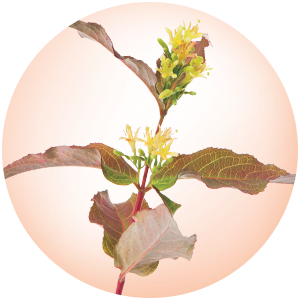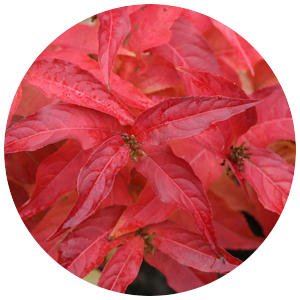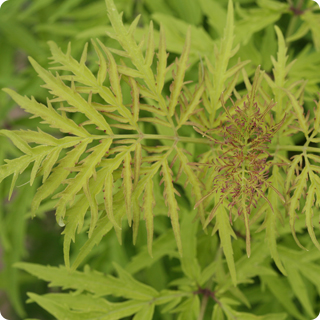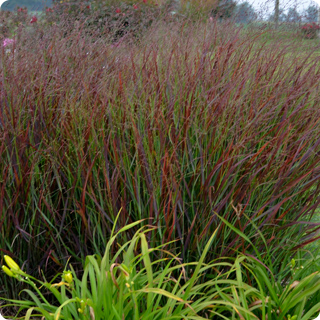KODIAK® ORANGE
DIERVILLA
An Eco-Friendly Alternative to Burning Bush
- One of the easiest shrubs you’ll ever grow
- Versatile, pollinator-friendly, native cultivar
- Glowing orange-red fall color
- Tolerates sun, shade and drought
- Not typically bothered by deer
- 3-4’ tall x 3-4’ spread
- Hardy in USDA Zones 4-7
- Pronounced “DEER-villa”
If there was an award for most easygoing shrub, Kodiak Orange diervilla would most certainly take first place. This fast growing shrub with native roots will grow just about anywhere in your landscape—sun or shade, moist or dry, even along the deer’s path. All summer long, its small, yellow flowers draw in pollinating bees and hummingbirds. The real show comes in autumn when its foliage glows the most vivid orange-red you could imagine, easily rivaling non-native burning bush.
how to grow kodiak orange® diervilla

Planting
Finding a place to plant Kodiak Orange diervilla is easy since it isn’t at all fussy about light, soil or moisture. It adapts to most soil types as long as it drains decently well. Keep in mind that sunlight is instrumental in the development of fall color, so to get the biggest impact give this plant at least 4-6 hours of sun if not all-day sun.
Consider planting a row of diervilla along the back of your perennial border where it will create a 3-4’ tall green backdrop in spring and summer and a wall of vivid orange-red color in fall. No room for a hedge? Plant a single Kodiak Orange specimen near an evergreen tree to make its contrasting fall color really pop.
When planting, dig the hole about twice as wide but just as deep as the container it is growing in. If the roots are densely circled around when you take the plant out of the pot, loosen them up a bit to break the “root memory”. This will encourage them to grow outward instead of continuing to grow in a circular pattern.
Set the plant in the hole, making sure that the top of the rootball is level with the top of the surrounding soil. Then backfill the hole with the soil you dug out. Press it down with your hand firmly to eliminate any big air pockets around the roots.
Lastly, water the plant again to help the soil settle. Spread some mulch around the base of the plant, taking care to keep it from touching the plant’s stems. The mulch will help to retain soil moisture and protect the roots during winter.

Pruning
If you don’t love to prune or have the time to do it, you’ll like hearing this: Kodiak Orange diervilla doesn’t need to be pruned. Ever. It can live its whole life without being touched by a pair of shears. Without any pruning, it will have a loosely rounded shape that is typical of many native shrubs. This is not a very dense growing plant like boxwood.
If you would prefer to do some pruning on your diervilla, the best time to do so is in early spring. Since this plant blooms on new wood, meaning this year’s branches, you will not risk cutting off any flower buds when you trim it in early spring. It is safe to cut back as much as 30% of the total size of the plant each spring. Doing so will make it grow a bit more densely. It can even be pruned into a semi-formal hedge.
While pruning in late fall won’t hurt the plant, it isn’t the best time to trim since it will be in its autumn glory that time of year. Better to just enjoy the fall show and prune in early spring.
Note that while one of the common names of Diervilla is bush honeysuckle, this plant is not invasive like certain honeysuckles are. You will not need to prune it to keep it from spreading—it will be well-behaved whether or not you prune.

Companion Plants
Since Kodiak Orange diervilla grows in such a wide range of conditions, the opportunities for planting partners are vast. Here are a few other hardy native cultivars that would pair beautifully with diervilla.
Lemony Lace® elderberry grows in sun or part shade and is also deer resistant. Its yellow foliage would echo the yellow flowers of diervilla and contrast sharply with diervilla’s orange-red fall color.
Ginger Wine® ninebark is a durable native shrub for full sun. Its burgundy summer foliage would bring more interest to the space before the diervilla put on its fall show.
Berry Heavy® winterberry holly grows in sun or shade and bears vivid red berries in the fall which would complement the diervilla’s fall foliage. Its persistent fruits would continue to provide color long after the diervilla dropped its leaves.
Prairie Winds® ‘Cheyenne Sky’ switch grass would offer a graceful contrasting texture to diervilla in full sun spaces. From summer through fall, its deep red foliage color would complement the warm fall tones of diervilla.
‘Tuscan Sun’ perennial sunflower bears masses of bright gold blossoms from midsummer to fall in full sun. They would echo the yellow color of diervilla’s blooms and bring more color to the grouping before diervilla took over the color show in fall.
top 3 reasons to grow
kodiak® orange diervilla
IT’S GOOD TO PLANT MORE NATIVES
You can feel good about planting this shrub with native roots to help feed pollinators and reduce the need for watering in your landscape.
ABSOLUTELY FABULOUS FALL COLOR
If you are looking for an eco-friendly alternative to burning bush, you’ve found it here. Kodiak Orange diervilla’s brilliant orange-red fall color just might burn your retinas if you aren’t careful.
IT GROWS JUST ABOUT EVERYWHERE
Fussy is nowhere in this shrub’s vocabulary. Plant it in sun or shade in any decently well-drained soil and watch it flourish for decades to come.

Kodiak® Orange Diervilla x ‘G2X88544’ USPP27548 Can5596


